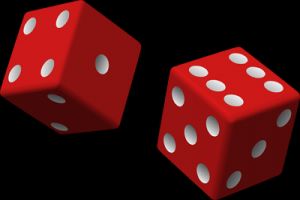Experienced calculus tutor - online and in-person. Schedule an affordable online calculus tutoring session.
Wednesday, October 26, 2016
About the theory of the probability II
Let's go back now to the game of our distinguished French men, Antoine Gombauld. The question was if the number 24 was a number of throws which you can rely on in this game of throwing two dices and get at least a double of six. An old rule of this game said that the bank could afford to bet with equal chances that any player should get at least a double of six from 24 throws of a pair of dices. However, de Mere was not convinced by that and he believed that this was not the right number. It seems that he realized from his own experience that 24 was not a sure number to bet on. However this statement is not likely to be true because the different tolerances of the chances were so small that would have had someone to play a long time to get a satisfactory experimental demonstration. It's almost sure now that his conclusion was based on theory and not on practice.
We don't know for sure how de Mere found the correct solution to this problem. Today we can solve this very easy and we will see that very soon. The idea is that de Mere consulted back then if he was right or not, a young French, Blaise Pascal, which he met shortly before at a reception offered by another important French men. Pascal was a philosopher, theologian and mathematician and he solved the problem proposed by de Mere and showed that the chances were slightly unfavorable to the bank if the bet was for 24 throws and was slightly favorable if the bet was for 25 throws.
Pascal solved also another problem which was much more interesting and harder and also proposed by de Mere. This second problem, already famous, has been discussed so many times but never solved correctly. It was called "the problem of the parts" or "the problem of the division". In general the problem was of this kind: in what way we could share the money between the players if from one reason or another, the games had to be interrupted before it was finished, the players having just partial results? Pascal introduced the important idea that the size of the price earned by a player in a partial game must depend on the probability of that player to win the game, in the case of ending it. Pascal showed with details how we can find the probability of one to win by knowing the nature of the game and the partial result of very player.
De Mere questions and the solutions proposed by Pascal proved to be very stimulative and important. Pascal wrote about these problems to another famous French, Pierre de Fermat, which had a great reputation back then as a mathematician and also he was a distinguished jurist in Toulouse. The exchange of letters between these two mathematicians conducted to a deeper understanding of the mathematical aspect of these fortune games and become very popular those days. This way, in the elegant, but less recommended atmosphere of the game rooms, evoked in the correspondence of some eminent Frenchmen of the 17th century, was born "Mrs. Chance". Thank you.
Subscribe to:
Post Comments (Atom)

No comments:
Post a Comment